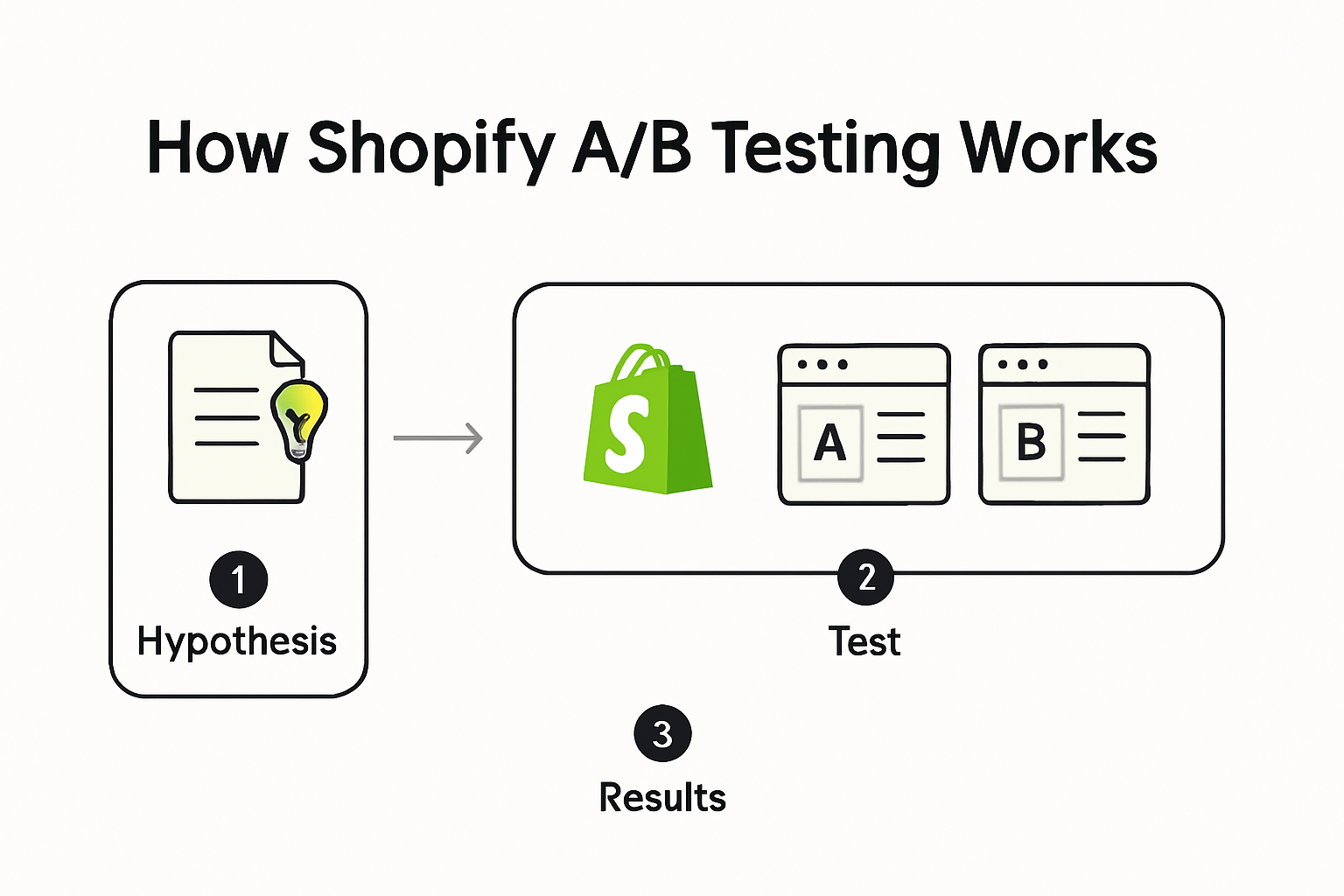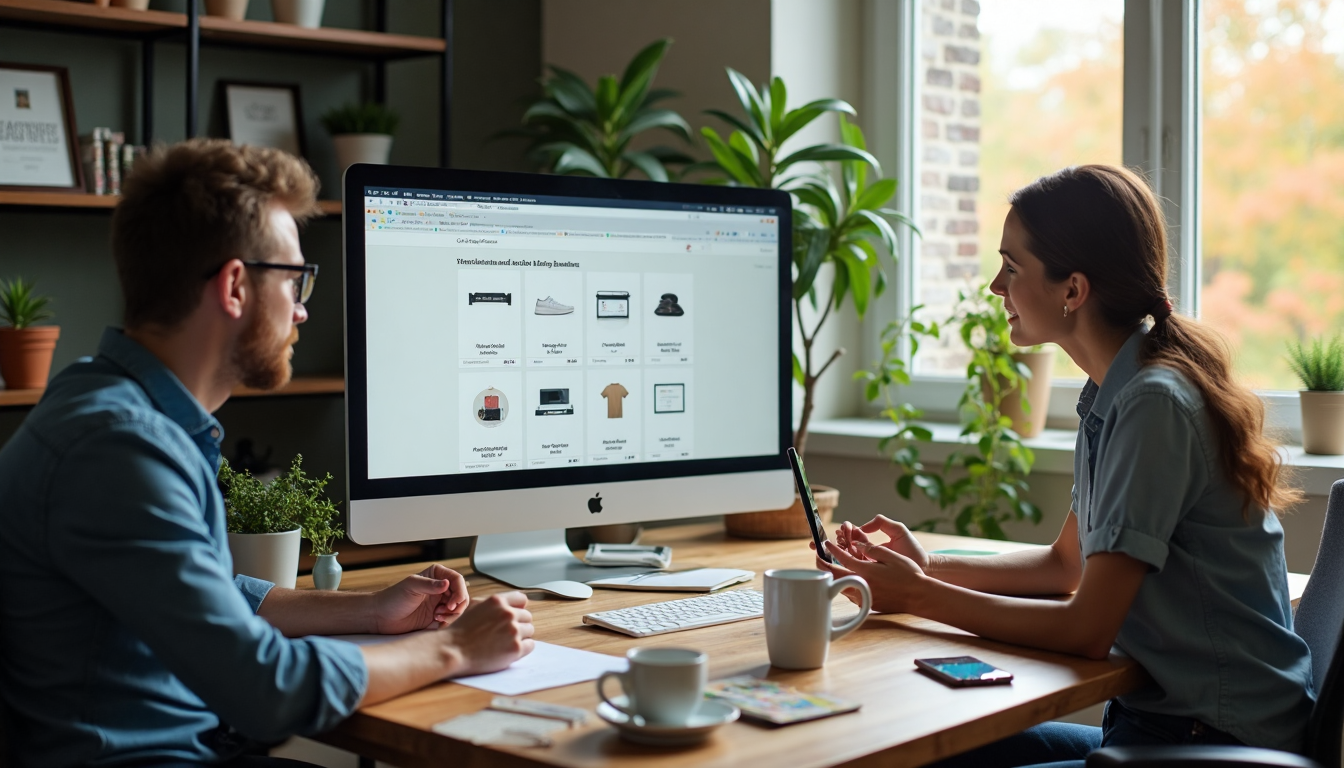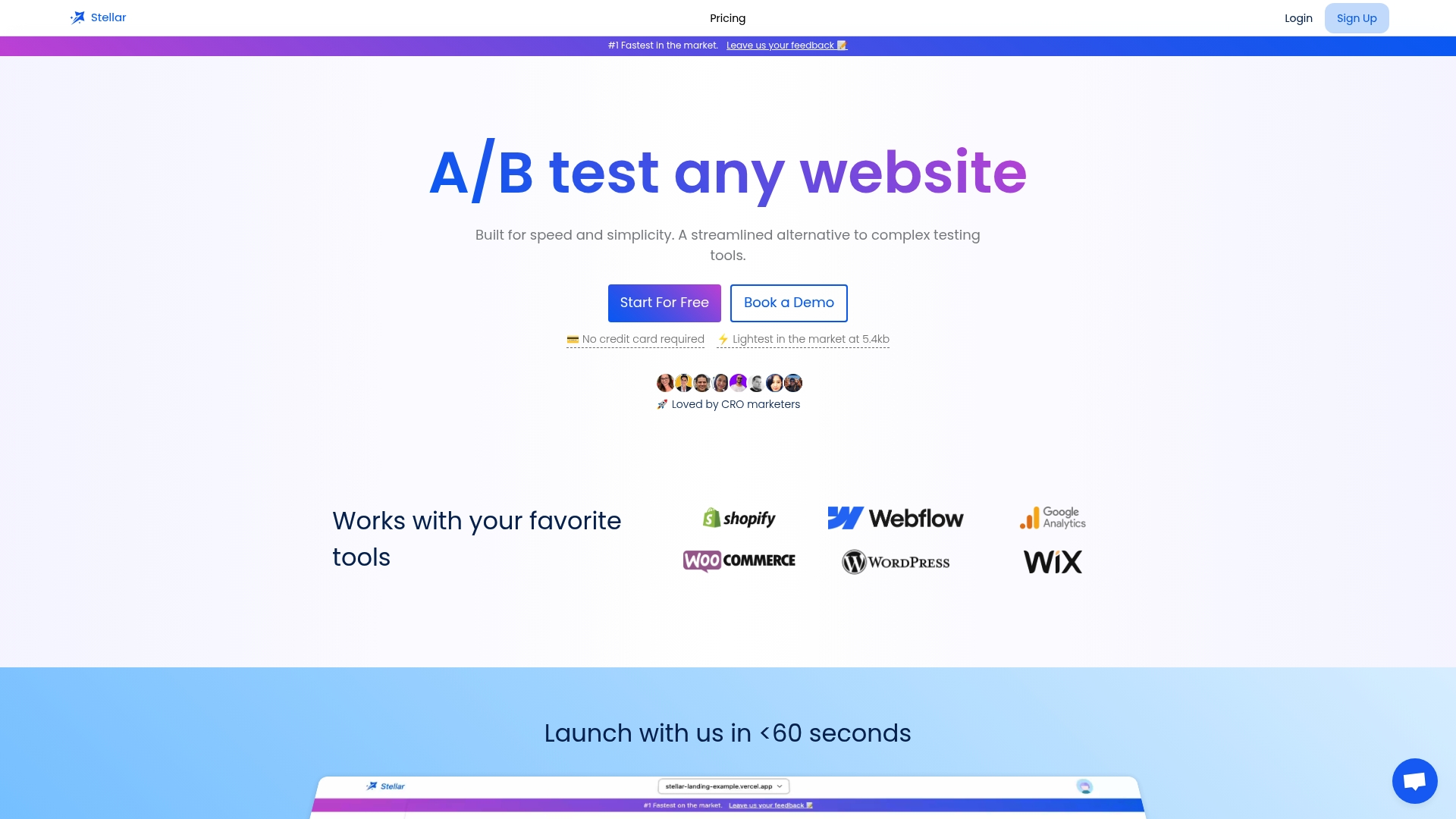
Shopify AB Testing: Boost Sales with Proven Strategies (2025)

Shopify merchants are always searching for an edge that can drive more sales, yet most changes feel like a shot in the dark. Here is a jaw-dropper. Just tweaking a checkout page or button color has driven conversion jumps as high as 21 percent in real-world tests. Most stores still leave this power untapped, stuck in endless guesswork. This is where systematic AB testing turns every hunch into a measurable win, unlocking sales growth others completely overlook.
Table of Contents
- Why Shopify AB Testing Matters For Growth
- Setting Up AB Testing In Shopify Step-By-Step
- Analyzing Results And Optimizing Your Store
- Top AB Testing Ideas For Shopify Success
Quick Summary
| Takeaway | Explanation |
|---|---|
| A/B Testing Drives Growth | Systematic A/B testing enables Shopify merchants to optimize elements like button colors or product descriptions, significantly enhancing conversion rates and revenue without major investments. |
| Data-Driven Decision Making | A/B testing provides empirical evidence, allowing merchants to make informed decisions tailored to their audience rather than relying on gut feelings or generic practices. |
| Continuous Improvement is Key | Establishing a culture of ongoing A/B testing helps merchants iteratively refine user experiences, ensuring that their strategies evolve with customer preferences and market trends. |
| Strategic Experimentation Techniques | Focus on essential areas such as call-to-action designs, checkout processes, and product page layouts to maximize the effectiveness of A/B tests and drive conversions. |
| Analyze Results for Insights | Prioritize robust statistical significance in test outcomes to extract meaningful insights, guiding future optimizations and enhancing customer engagement over time. |
Why Shopify AB Testing Matters for Growth
In the competitive world of e-commerce, understanding the nuanced impact of design, messaging, and user experience can transform a struggling online store into a revenue-generating powerhouse. Shopify AB testing emerges as a critical strategy for businesses seeking data-driven growth and precision in their optimization efforts.

The Economic Impact of Strategic Experimentation
Every digital interaction represents a potential conversion opportunity. Research from the International Conference on Management & Entrepreneurship Research demonstrates that AI-integrated A/B testing frameworks enable e-commerce platforms to process complex data volumes and identify subtle performance patterns. This means merchants can make informed decisions that directly impact their bottom line.
The economic significance of A/B testing is profound. Conversion rate optimization through systematic experimentation can yield substantial returns. A seemingly minor change—such as adjusting button color, refining product descriptions, or restructuring checkout processes—can generate significant revenue increases. For Shopify store owners, this translates to tangible growth without massive infrastructure investments.
Data-Driven Decision Making in E-commerce
Traditional business strategies often rely on intuition or generic best practices. A/B testing disrupts this approach by providing empirical evidence of what truly resonates with your specific audience. According to a systematic literature review, A/B testing is predominantly used to optimize algorithms and visual elements, with primary applications in feature selection and development.
For Shopify merchants, this means moving beyond guesswork. Instead of implementing changes based on assumptions, you can systematically test variations and understand exactly how your audience responds. Whether it's testing product page layouts, email marketing campaigns, or promotional strategies, A/B testing offers a structured method to validate hypotheses and minimize risk.
Continuous Improvement Through Experimentation
Successful e-commerce is not about making one perfect change but establishing a culture of continuous improvement. A/B testing provides a framework for ongoing optimization. By consistently testing and iterating, Shopify store owners can create increasingly refined user experiences that convert more effectively.
The science behind email marketing optimization illustrates this principle. A study showed that strategic testing could increase conversion rates from 5% to 12%—a remarkable improvement achievable through methodical experimentation.
Moreover, modern A/B testing tools like Stellar simplify this process, enabling even non-technical entrepreneurs to conduct sophisticated experiments. With lightweight scripts and intuitive interfaces, merchants can now access advanced optimization techniques previously reserved for large corporations.
By embracing Shopify AB testing, businesses transform uncertainty into opportunity. Each experiment becomes a stepping stone toward more intelligent, responsive, and ultimately more profitable e-commerce strategies.
Setting Up AB Testing in Shopify Step-by-Step
Successful A/B testing in Shopify requires a strategic approach that combines technical setup with analytical precision. While many merchants feel overwhelmed by the experimentation process, breaking it down into manageable steps can transform complex testing into an actionable growth strategy.
Preparing Your Shopify Store for Systematic Experimentation
Before diving into A/B testing, you need a solid foundation. According to Gelato's comprehensive guide, the initial preparation involves several critical components. First, ensure your Shopify store has sufficient traffic to generate statistically significant results. Typically, you'll want at least 1,000 monthly visitors to conduct meaningful experiments.
Identify key performance indicators (KPIs) that directly impact revenue. These might include conversion rates, average order value, or cart abandonment rates. Performance metrics will serve as your primary measurement tools. Selecting the right metrics prevents getting lost in vanity data that doesn't translate to actual business growth.
Developing and Implementing Test Variations
CartCoders' expert guide recommends a structured approach to creating test variations. Start by developing clear hypotheses about potential improvements. For instance, you might hypothesize that changing a product page's call-to-action button color could increase click-through rates.
Create your test variations with precision. This could involve:
- Modifying button colors or placement
- Adjusting product description language
- Changing image layouts
- Experimenting with pricing display
- Testing different checkout process designs
Each variation should be fundamentally different yet remain consistent with your brand's overall aesthetic. Learn more about advanced testing strategies to refine your approach.

Executing and Analyzing Your A/B Tests
Kameleoon's user manual highlights the importance of proper test execution. Use Shopify-compatible A/B testing tools that integrate seamlessly with your platform. These tools should provide:
- Real-time data tracking
- Statistical significance calculations
- Comprehensive result visualization
- Easy variation management
Run your tests for a sufficient duration—typically 2-4 weeks—to capture comprehensive data across different customer segments and behaviors. Avoid making premature decisions based on limited data.
After completing the test, analyze the results objectively. Look beyond surface-level metrics to understand deeper user behavior patterns. A winning variation isn't just about immediate conversion increases but potential long-term customer engagement improvements.
Remember that A/B testing is an ongoing process of incremental optimization. Each test provides insights that inform future experiments, creating a continuous improvement cycle for your Shopify store. By systematically approaching testing, you transform guesswork into a data-driven growth strategy that consistently enhances your online business performance.
To help you visualize the step-by-step process of setting up and running A/B testing on Shopify, here's a table summarizing the key phases involved:
A/B Testing Setup Steps for Shopify Stores
| Step | Description |
|---|---|
| 1. Prepare Store | Ensure sufficient traffic & identify KPIs (e.g., conversion rate, order value) |
| 2. Form Hypotheses | Develop informed ideas about what changes could improve results |
| 3. Create Variations | Design testable alternatives (button color, descriptions, layouts, pricing, etc.) |
| 4. Implement Testing Tools | Use integrated A/B testing platforms for real-time tracking and management |
| 5. Run Tests | Let experiments run 2-4 weeks to gather reliable, statistically significant data |
| 6. Analyze Results | Examine both surface and deeper behavioral metrics to determine winners |
| 7. Apply & Iterate | Implement winning changes and continue with new tests for continuous improvement |
Analyzing Results and Optimizing Your Store
Successful A/B testing goes far beyond simply running experiments. The true value lies in meticulously analyzing results and translating insights into strategic store optimizations that drive tangible business growth.
Understanding Statistical Significance and Meaningful Insights
A comprehensive review of online controlled experiments emphasizes the critical need for robust statistical approaches in e-commerce testing. Not all test results are created equal. Statistical significance determines whether observed differences are genuine improvements or mere random fluctuations.
When analyzing A/B test outcomes, focus on key metrics that directly impact revenue. Conversion rate, average order value, and customer lifetime value serve as primary indicators of test success. Look beyond surface-level numbers to understand deeper user behavior patterns. Explore advanced conversion strategies to gain deeper insights into your optimization efforts.
Advanced Data Interpretation Techniques
Research examining Multi-Armed Bandit algorithms reveals sophisticated approaches to dynamic content optimization. Thompson sampling emerged as a particularly effective method for determining the most promising variations. This technique goes beyond traditional A/B testing by continuously adapting and learning from ongoing experiment data.
Consider the nuanced dependencies in your test results. Recent studies highlight that transaction values and sizes can significantly impact measurement accuracy. Merchants must account for these complex interactions to avoid misleading conclusions. Key considerations include:
- Segment-specific performance variations
- Time-based behavioral differences
- Contextual factors influencing user decisions
Implementing Continuous Optimization Strategies
Transforming test results into actionable improvements requires a systematic approach. Create a structured workflow for implementing winning variations:
- Validate statistical significance
- Understand underlying user behavior drivers
- Develop comprehensive implementation plan
- Monitor long-term performance impacts
- Iterate and refine continuously
Remember that optimization is an ongoing process. Each A/B test provides incremental insights that compound over time. The most successful Shopify stores view testing not as a one-time activity but as a continuous learning and improvement cycle.
Avoid common pitfalls such as:
- Making decisions based on insufficient data
- Implementing changes without comprehensive understanding
- Neglecting to document and learn from unsuccessful tests
By approaching A/B testing as a strategic discipline, you transform raw data into a powerful mechanism for sustained business growth. Each experiment becomes a stepping stone toward a more refined, user-centric shopping experience that consistently drives conversions and customer satisfaction.
Top AB Testing Ideas for Shopify Success
Maximizing your Shopify store's performance requires strategic experimentation across multiple dimensions of user experience. The most successful merchants view A/B testing not as a sporadic activity but as a systematic approach to continuous improvement.
To help compare and organize some of the most impactful testing areas mentioned, here's a table summarizing key A/B testing ideas, their examples, and potential impact based on insights in this article:
Key Shopify A/B Testing Areas and Potential Impact
| Area | Example Test | Potential Impact |
|---|---|---|
| Design Elements | Button color or CTA text | Up to 21% conversion uplift |
| Checkout Experience | Simplifying forms, adding security | Up to 60% reduction in abandonment |
| Product Pages | Image/description changes, social proof | Improved engagement & conversions |
| Pricing Presentation | Psychological pricing, showing discounts | Increase perceived value |
| User Navigation | Variant selectors, progress indicators | Smoother, faster checkout |
Conversion-Driving Design Elements
Research from e-commerce optimization studies reveals that seemingly minor design modifications can generate significant performance impacts. Call-to-action optimization stands at the forefront of these strategies. Comprehensive testing methodologies suggest experimenting with elements like:
- Button colors and placement
- Button text variations
- Descriptive vs. action-oriented language
- Size and prominence of conversion elements
Interestingly, color psychology research demonstrates that button color can dramatically influence conversion rates. One study found red buttons outperformed green buttons by 21%, highlighting the nuanced impact of visual design choices.
Streamlining User Experience and Checkout
The checkout process represents a critical conversion bottleneck for many Shopify stores. Optimization research indicates that strategic simplification can decrease cart abandonment rates by up to 60%. Key areas for experimentation include:
- Reducing form fields
- Implementing progress indicators
- Offering guest checkout options
- Displaying security badges
- Providing multiple payment methods
- Simplifying navigation during checkout
Consider testing different layouts that minimize cognitive load. Remove unnecessary steps, provide clear direction, and create a sense of security and trust throughout the purchasing journey.
Product Page and Pricing Experimentation
Product pages serve as the critical intersection between customer interest and conversion. Advanced Shopify merchants recognize the power of nuanced testing strategies. Potential experiment areas include:
- Product image quantity and quality
- Description length and formatting
- Social proof integration
- Pricing display techniques
- Shipping information presentation
- Variant selection interfaces
Pricing presentation can significantly impact perceived value. Test strategies like displaying original prices, using psychological pricing techniques, or showing comparative value propositions.
Remember that successful A/B testing is an iterative process. No single test provides a permanent solution. Continuously monitor, adapt, and refine your approach. Each experiment offers insights that compound over time, gradually transforming your Shopify store into a high-converting, user-centric shopping experience.
By systematically testing and implementing data-driven improvements, you create a dynamic store that consistently adapts to evolving customer preferences and market trends.
Frequently Asked Questions
What is A/B testing in Shopify?
A/B testing, also known as split testing, involves comparing two versions of a webpage or element—such as a checkout page or button color—to determine which one performs better in terms of conversions and sales.
Why is A/B testing important for e-commerce?
A/B testing is crucial for e-commerce because it allows merchants to make data-driven decisions based on actual user behavior, which can lead to significant improvements in conversion rates and overall sales without the need for large investments.
How do I set up A/B testing in my Shopify store?
To set up A/B testing in Shopify, prepare your store by ensuring sufficient traffic, develop clear hypotheses for what you want to test, create variations, and use compatible testing tools to execute and analyze your tests over a few weeks.
What are some effective A/B testing ideas for Shopify?
Some effective A/B testing ideas for Shopify include experimenting with design elements like button colors, optimizing the checkout experience, testing product page layouts, and experimenting with pricing strategies to see what converts best.
Unleash Real Shopify Growth With Effortless A/B Testing
You want to break free from guesswork and finally see your store’s conversion rates climb. The article highlighted how A/B testing is the proven path to real results in Shopify. But many store owners struggle with complex tools, slow load times, and limited technical resources. Struggling to measure which button color or checkout sequence works best? You are not alone, and every day you wait costs your business hard-earned sales.

Take control of your optimization journey today. Stellar makes A/B testing simple and lightning fast for every marketer and growth-minded business owner. Set up tests in minutes using a no-code visual editor. Watch real-time analytics guide your next steps. Get advanced features like dynamic keyword insertion and goal tracking without ever needing a developer.
Be the brand that consistently stays ahead and adapts to customer behavior with the fastest, most lightweight tool on the market. Visit Stellar’s pricing and feature page now and see how top Shopify stores are pushing conversion rates higher with every experiment. There is a free plan waiting for you—start building your winning store today.
Recommended
- Testing to Optimize Conversions: CRO Strategies for 2025
- Qu'est-ce que le test AB en marketing digital : Le guide ultime pour améliorer les résultats des campagnes
- 10 Inspirerende AB-test Voorbeelden voor CRO-marketeers in 2025
- SEO AB Test Strategies for CRO Marketers in 2025
- Conversion Rate Optimization Strategies for Marketers in 2025
- SaaS Marketing Optimization: Test Smarter, Not Harder
Published: 7/1/2025